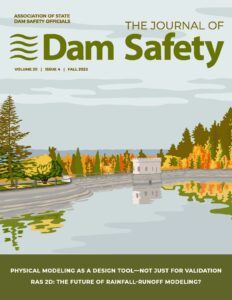Expertise on Scaled Physical Modeling Featured in The Journal of Dam Safety
Using scaled physical models as an integral part of dam design can improve the process by optimizing hydraulic performance, exposing unforeseen potential challenges, and possibly reducing construction costs, Freese and Nichols’ Water Resource Design specialists Brad Kirksey and Tina McMartin write in the newest issue of The Journal of Dam Safety, published by the Association of State Dam Safety Officials.
In the article, co-authored with Blake Tullis of Utah State University, they provide extensive step-by-step advice on best practices in choosing, building and testing scaled physical models.
The authors offer their tips in “Physical Modeling as a Design Tool—Not Just for Validation” as an industry resource to improve the effectiveness of modeling and give design teams and owners deeper understanding and greater confidence in the hydraulic performance of their structures.

The article is based on 20 years of collaboration between Freese and Nichols and the Utah Water Research Laboratory at Utah State University on more than 10 different scaled physical models — for new dam and spillway design, dam rehabilitations, spillway modifications, and spillway dewatering system design. Examples cited include Leon Hurse Dam for the new Lake Ralph Hall, which is owned by Upper Trinity Regional Water District in North Texas; modernization of the Upper Brushy Creek Water Control and Improvement District’s Dam 7 in Texas’ Brazos River basin; and Bois d’Arc Lake dam, owned by the North Texas Municipal Water District.
The practices they advise include:
- Using sectional models or phased models to refine geometry before constructing the full model, developing the full model with the components to test in mind
- Building the model such that components can be enlarged, reduced, or reconfigured
- Reducing the footprint of the full model by using computational fluid dynamics (CFD) modeling to extrapolate results
- Using pressure taps to evaluate stagnation pressures for spillway stability
- Documenting the entire model with photo and video
- Using the physical model to calibrate CFD models for posterity after the physical model is demolished
Brad, based in El Paso, is a water resources design project manager and engineer and leads our Water Resource Design Technical Excellence Program. Tina is a water resources project manager and engineer based in Austin. And Blake is Associate Vice President, Office of Research, at Utah State University. He was associate director of the Utah Water Research Laboratory in 2015-2019.

